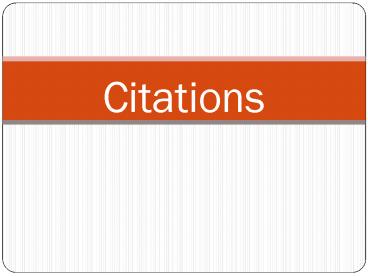Citations PowerPoint PPT Presentation
Title: Citations
1
Citations
2
Why do we cite?
- To give credit for others ideas
- So that other people can find our sources
- So they can check the accuracy of facts
- So they can use our sources in their own research
- Just because somebody put their research/writing
on the internet doesnt mean that its right for
you to copy it.
3
When do we cite?
- When using a direct quote
- When paraphrasing another authors work
- When referencing someone elses opinion
- When using a fact that is not common knowledge
The only time you should not be citing a source
is when discussing something that is common
knowledge or your own opinion.
4
In Text Citations
- The citation or the sentence should always
include the author or title of the source, the
year of publication, and a page number - At the end of a sentence where youve used a
source, insert a citation before the period - According to the article, a potential cause of
depression in teens is academic pressure to
perform well in high school and to be admitted to
college (Bloom, 2001, 21). - Author is the default, title should only be used
if there is no author - If the source has no year, use n.d. (Bloom, n.d.)
- If there are no page numbers, skip the page
number completely (Bloom, 2001) - The author or title should correspond to the
entry in your Works Cited page so readers can
find it easily
5
Making a References Page
- Each entry is single spaced, but double space
between entries - Organize the entries alphabetically
- The word References should always appear,
centered, at the top of the page
6
Citing Books
- Author, A. (Date of Publication). Title of book.
Place of Publication Publisher. - Salinger, J.D.. (1951). The Catcher in the rye.
New York Little Brown and Company. - Clark, J. (2006). Eyewitness history The
gilded age. New York Facts on File.
7
Citing an Article in a Reference Book
- Author, A.(Year of publication). Title of
article. In A. Editor, Title of book (pages of
chapter). Location Publisher. - Williams, W. (2009). Psychology. In Smith, J,
Encyclopedia Brittanica (673-677). New York
Oxford University Press. - (2002). Psychology. In History of Modern
Science and Mathematics. New York Charles
Scribners Sons.
8
Citing Academic Journal Articles
- Author, A. (Date of publication). Title of
article. Title of Journal, volume number(issue
number), page range. - Burgess, A. (1967). Politics in the novels of
Graham Greene. Literature and Society, 2(2),
93-99. - Williams, T. (2011). Evolutionary psychology.
Scientific American, 34(5), 65-66.
9
Citing an Article from a Database
- Lucky for you, APA doesnt have a special
citation for online sources from databases. Just
cite them as though they were in print!
10
Citing Websites
- Author, A. (Date of publication including day
and month if available). Title of document.
Retrieved from http//www.webaddress.com - How to make vegetarian chili. (n.d.). Retrieved
from http//www.ehow.com/recipes/vegetarianchili.
ht ml/ - Angeli, E., Wagner, J. (2010, May 5). General
format. - Retrieved from http//owl.english.purdue.edu/ow
l/resource/560 /01/
11
Where to Go for Reminders
- The OWL
- http//owl.english.purdue.edu/owl/resource/560/01/
- Cornell U. Library
- http//www.library.cornell.edu/resrch/citmanage/ap
a - Noodle Tools Express Citation Generator
- http//www.noodletools.com/
- Or you can look in a book! We have plenty of APA
handbooks just waiting to be taken out!
12
Questions?

